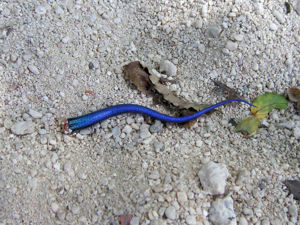Difference between revisions of "Lizard Musculoskeletal System"
m |
|||
| (8 intermediate revisions by 3 users not shown) | |||
| Line 1: | Line 1: | ||
| − | {{ | + | {{OpenPagesTop}} |
| − | [[Image:Lizard_autotomy.jpg|300px|thumb|right|'''Lizard tail after autotomy''' | + | ==Introduction== |
| + | [[Image:Lizard_autotomy.jpg|300px|thumb|right|'''Lizard tail after autotomy''' (© Metatron, Wikimedia Commons]] | ||
Like other reptiles, lizards have a single occiptal condyle. Ribs are present on all vertebrae except tail and cervical vertebrae. | Like other reptiles, lizards have a single occiptal condyle. Ribs are present on all vertebrae except tail and cervical vertebrae. | ||
==Autotomy== | ==Autotomy== | ||
| − | Several families of lizard can voluntarily discard the tail when seized by a predator. The discarded wriggling tail is thought to distract the attention of the predator, enabling the lizard to escape | + | Several families of '''lizard''' can voluntarily '''discard the tail''' when seized by a predator. This is known as''' autotomy'''. The discarded wriggling tail is thought to '''distract the attention of the predator''', enabling the lizard to escape. |
| − | + | In a '''clinical scenario''', autotomy may occur when the lizard is being '''restrained'''. It is important to be prepared for (and try to prevent) this occurrence. | |
| + | Autotomy and regeneration occur in many '''[[Lizard Classification|iguanid]]''' species but not in many [[Lizard Classification|agamids]], [[Monitor|monitors]] and [[Chameleon|chameleons]]. | ||
| + | |||
| + | Lizards that are capable of autotomy have a '''vertical fracture plane''' through the body and part of the neural arch of the tail vertebrae. This is a '''plate''' of '''cartilage or connective tissue''' that develops after ossification. The vasculature supplying the tail immediately '''spasms''' when autotomy occurs, which stops any [[Haemorrhage|haemorrhage]]. | ||
| + | |||
| + | If the tail is completely discarded, it '''cannot be reattached''' due to the disruption to the blood supply of the tail. The animal is able to '''grow a new tail''' - growth normally begins after approximately one month, and is complete after approximately one to two years. The regenerated tail is '''never as long or well formed''' as the original and may have a slightly different scale colour and pattern. | ||
| + | |||
| + | {{Learning | ||
| + | |flashcards = [[Reptiles and Amphibians Q&A 24]] | ||
| + | }} | ||
==References== | ==References== | ||
| + | * Frye, FL & Williams, DL (1995) '''Self-Assessment Colour Review - Reptiles & Amphibians''' ''Manson'' | ||
| + | * Mader, DR (2005) '''Reptile Medicine and Surgery''' Saunders. ''pp. 1264. ISBN 072169327X'' | ||
| + | |||
| + | |||
| + | {{review}} | ||
| + | |||
| + | {{OpenPages}} | ||
| − | |||
[[Category:Lizard_Anatomy|M]] | [[Category:Lizard_Anatomy|M]] | ||
| + | [[Category:Expert Review - Exotics]] | ||
Latest revision as of 18:17, 26 July 2012
Introduction
Like other reptiles, lizards have a single occiptal condyle. Ribs are present on all vertebrae except tail and cervical vertebrae.
Autotomy
Several families of lizard can voluntarily discard the tail when seized by a predator. This is known as autotomy. The discarded wriggling tail is thought to distract the attention of the predator, enabling the lizard to escape.
In a clinical scenario, autotomy may occur when the lizard is being restrained. It is important to be prepared for (and try to prevent) this occurrence.
Autotomy and regeneration occur in many iguanid species but not in many agamids, monitors and chameleons.
Lizards that are capable of autotomy have a vertical fracture plane through the body and part of the neural arch of the tail vertebrae. This is a plate of cartilage or connective tissue that develops after ossification. The vasculature supplying the tail immediately spasms when autotomy occurs, which stops any haemorrhage.
If the tail is completely discarded, it cannot be reattached due to the disruption to the blood supply of the tail. The animal is able to grow a new tail - growth normally begins after approximately one month, and is complete after approximately one to two years. The regenerated tail is never as long or well formed as the original and may have a slightly different scale colour and pattern.
| Lizard Musculoskeletal System Learning Resources | |
|---|---|
 Test your knowledge using flashcard type questions |
Reptiles and Amphibians Q&A 24 |
References
- Frye, FL & Williams, DL (1995) Self-Assessment Colour Review - Reptiles & Amphibians Manson
- Mader, DR (2005) Reptile Medicine and Surgery Saunders. pp. 1264. ISBN 072169327X
| This article has been peer reviewed but is awaiting expert review. If you would like to help with this, please see more information about expert reviewing. |
Error in widget FBRecommend: unable to write file /var/www/wikivet.net/extensions/Widgets/compiled_templates/wrt693c808577c0a5_15609432 Error in widget google+: unable to write file /var/www/wikivet.net/extensions/Widgets/compiled_templates/wrt693c80857d69a3_83495410 Error in widget TwitterTweet: unable to write file /var/www/wikivet.net/extensions/Widgets/compiled_templates/wrt693c8085833646_01832068
|
| WikiVet® Introduction - Help WikiVet - Report a Problem |
